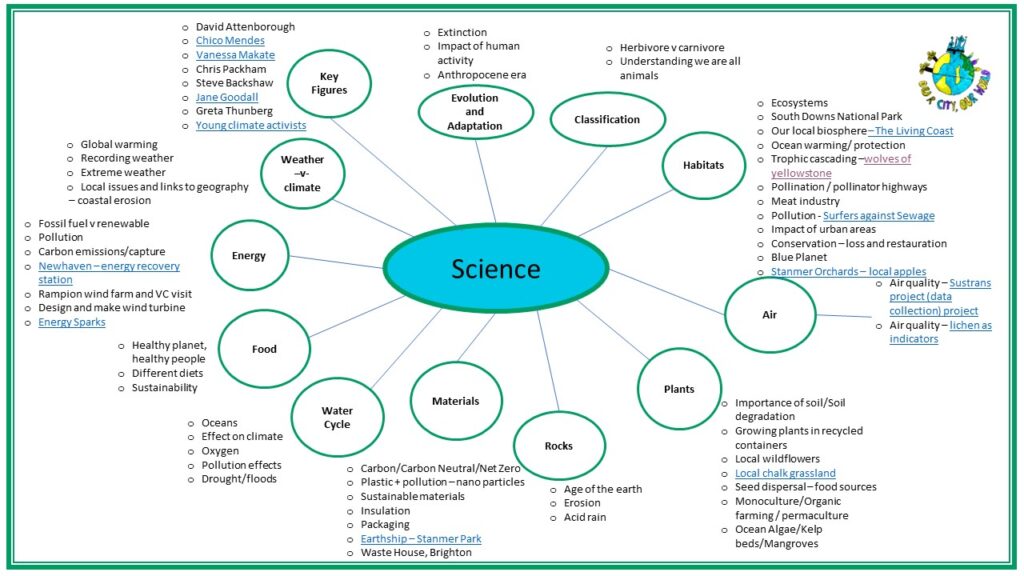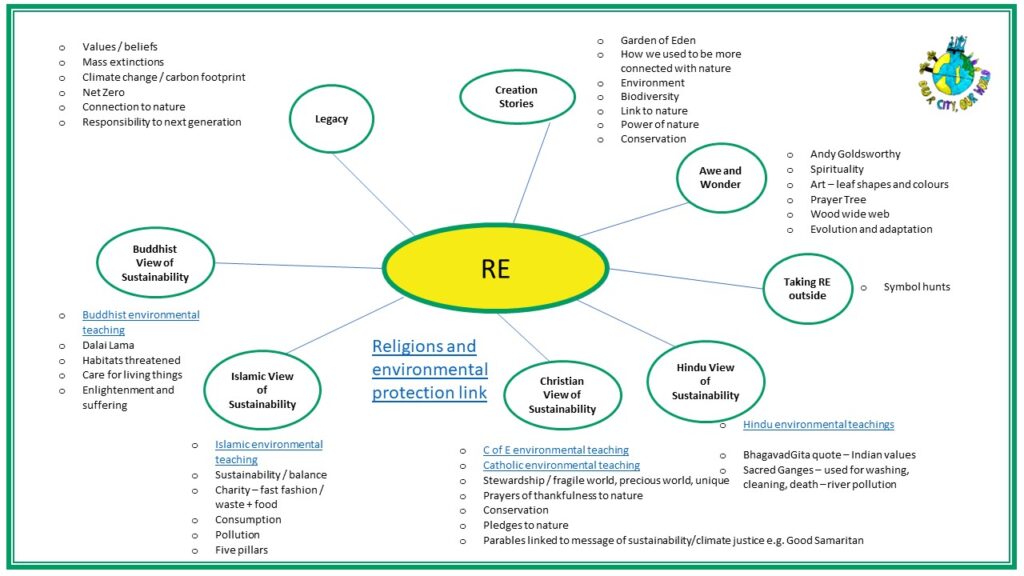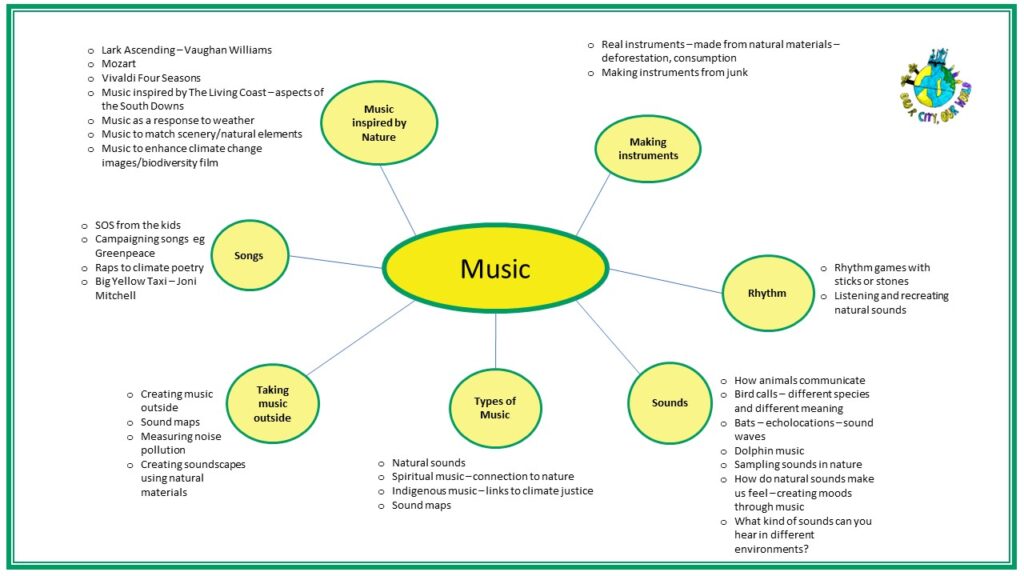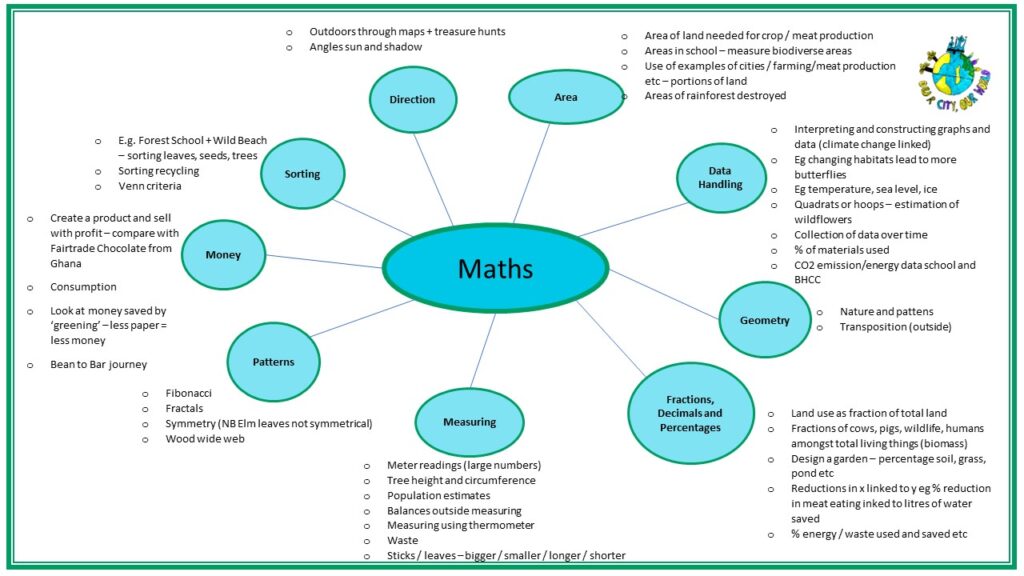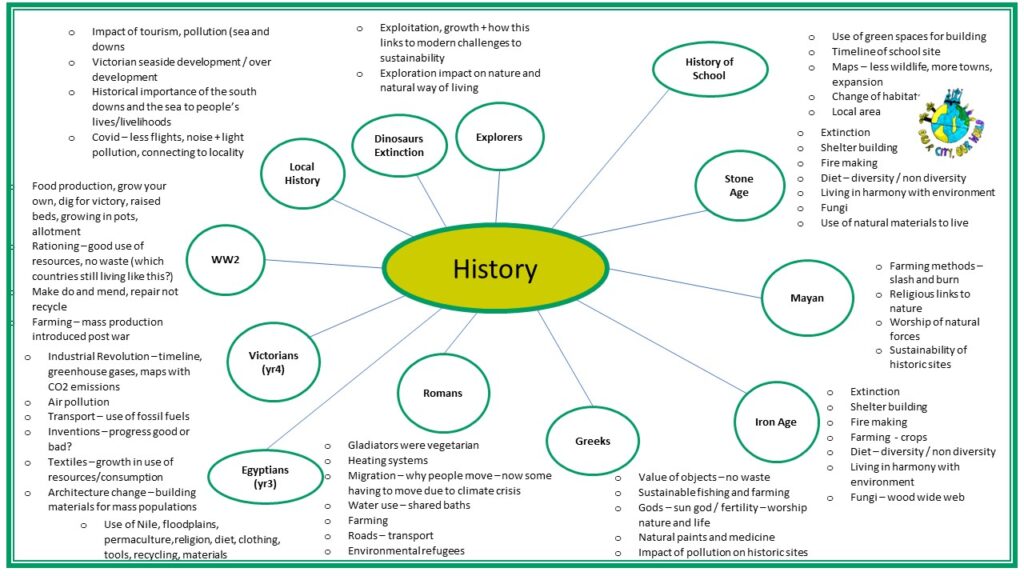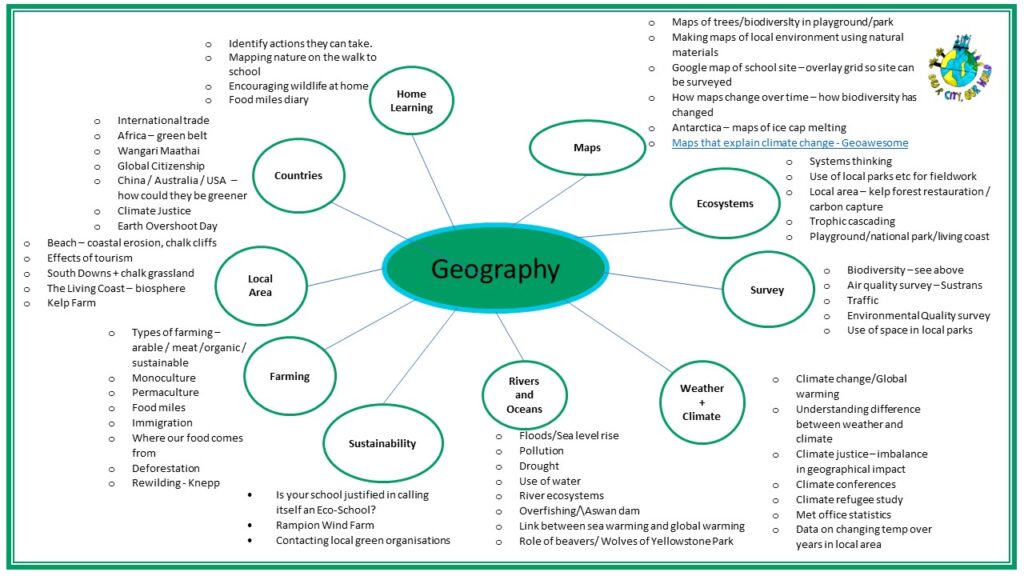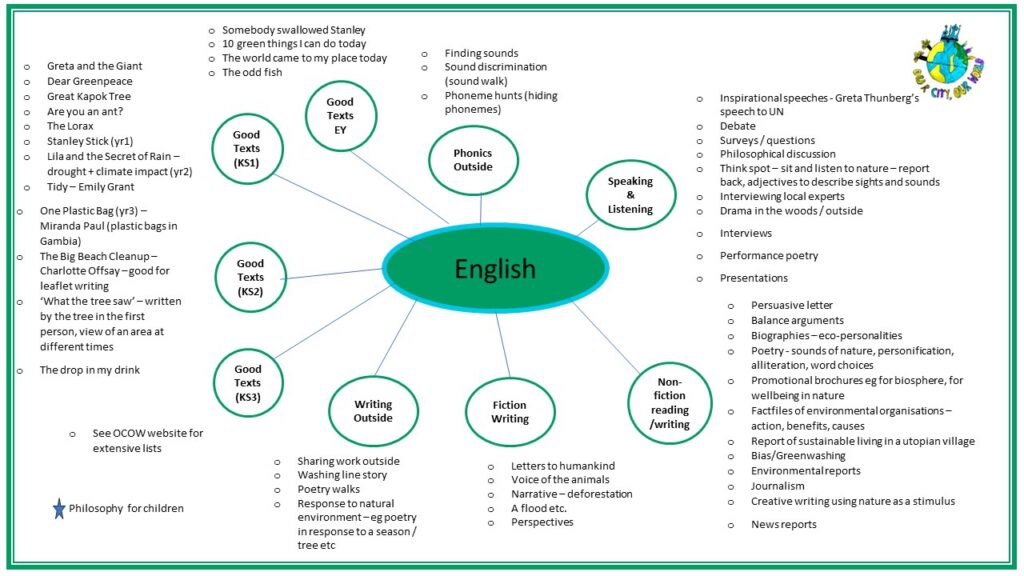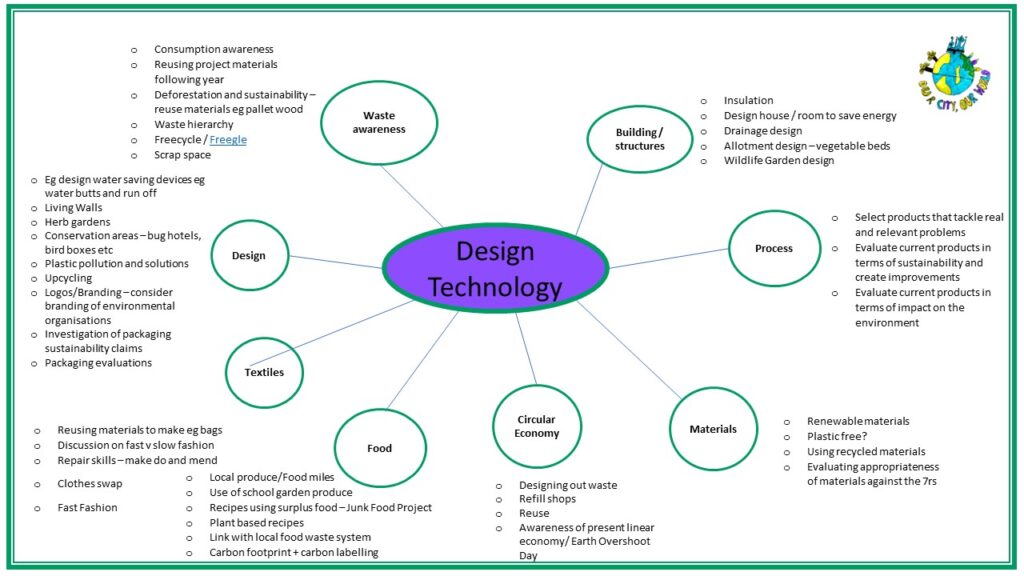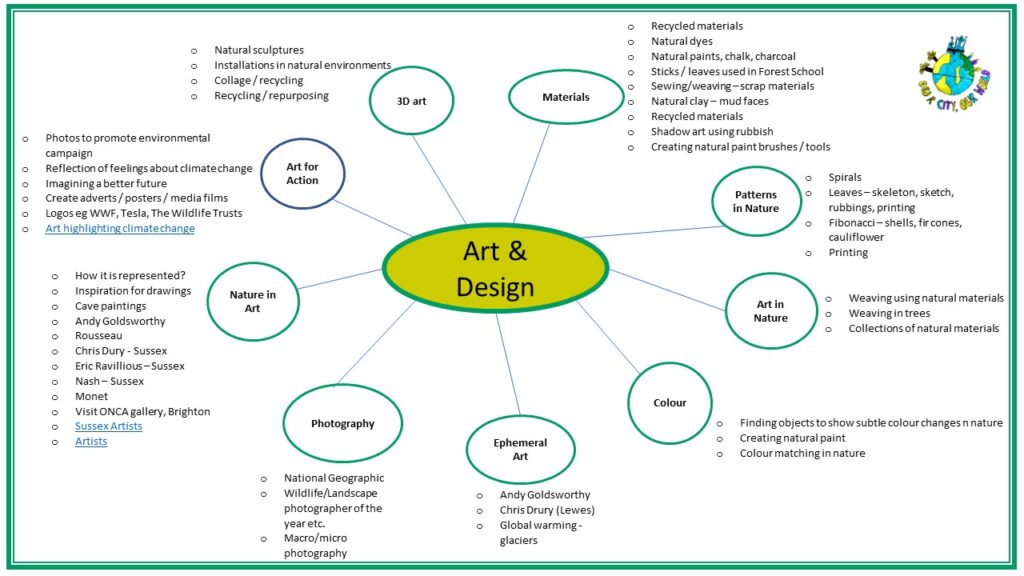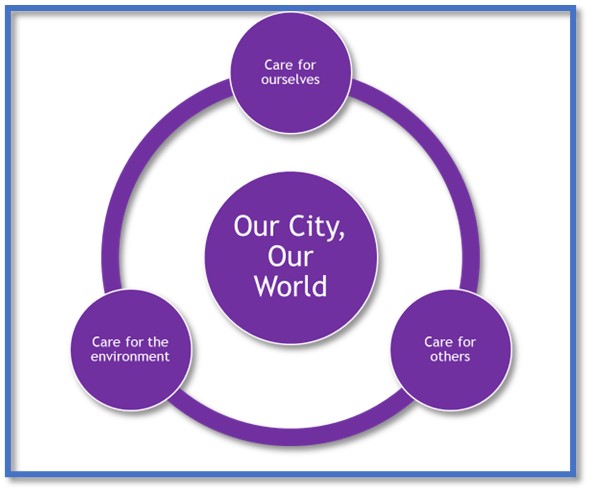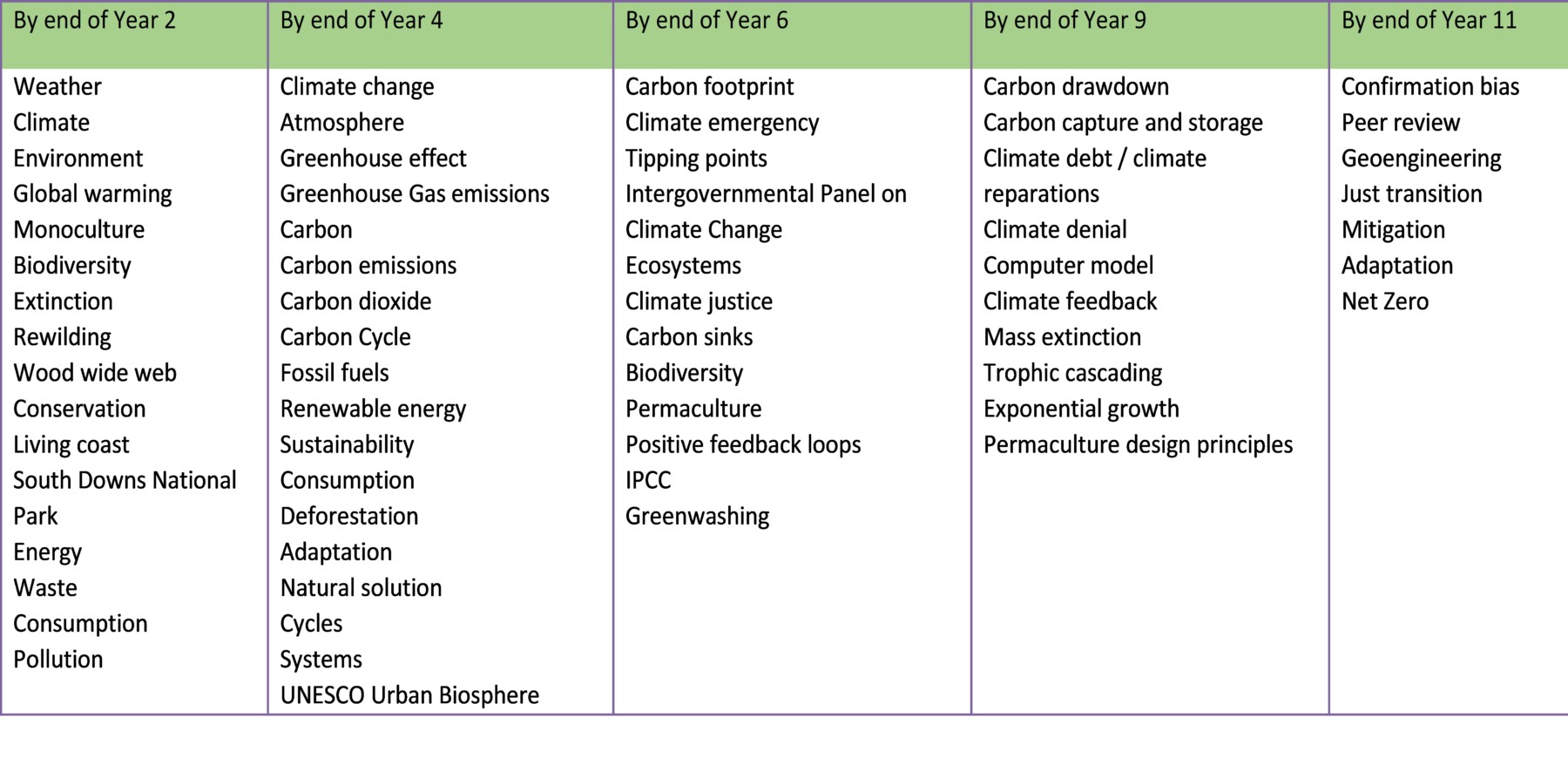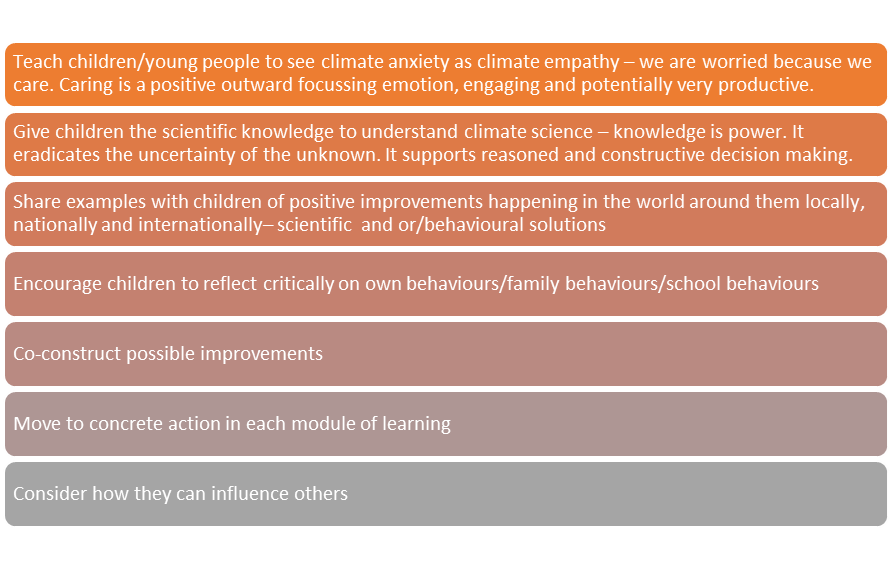The Framework
It is already very difficult to fit the present National Curriculum successfully into the school timetable. Therefore, the Our City, Our World programme is realistic in that it aims to support schools in integrating a progressive climate change, sustainability and environmental education programme into their present curriculums so it does not require more time.
We work with schools in approaches to greening the curriculum i.e.
-
changing the context of the present curriculum to place it in a more climate change/sustainability context
-
finding purposeful and effective ways of connecting learning with the outdoors/nature
-
linking it to whole school improvement
This approach is also better for several key reasons:
-
The learning is placed in a meaningful context within the present curriculum rather than as isolated modules
-
Children and young people learn the key skills and knowledge holistically across all subjects
-
Learning is linked closely to sustainability improvements within the whole school
-
Children and young people learn to see the world consistently through a green lens
‘Greening the curriculum’
Working with our pilot schools, we have come up with possible examples of the integration of learning about climate change and sustainabiity into your present curriculum so existing skills progressions are not undermined. The examples illustrated are by no means an exhaustive list; they will on the other hand enable you and you staff to begin to understand what we mean by seeing the curriculum ‘through a green lens’. They will be a good starting point and discussion area for teacher planning of the integration of climate change and sustainability skills and knowledge into your present subject modules.
To aid schools in establishing this approach with staff, below is a draft policy to be adapted to your own school context through work with all members of your school community.
………………………. school
Teaching and learning policy to support
the sustainability and climate change curriculum
Our Vision
Our school’s curriculum is an embodiment of our vision and values. Treating environmental sustainability as a core value leads to all members of our school taking responsibility for its effective integration in our curriculum and beyond into school life.
Insert school vision for SCCEE
We know that young people are anxious to create a greener, more sustainable world, and to tackle both the causes and impact of climate change. Through a better understanding of the facts, a greater appreciation of nature, and practical opportunities to participate in activities to increase climate resilience and enhance biodiversity, we will empower all young people to be truly global citizens, able to take positive steps to improve their local communities, their country and the planet, now and in the future. Through this process they will come to recognise themselves as changemakers.
Intent
We have put care for and learning in the environment at the heart of the curriculum experience so pupils develop positive attitudes and behaviours towards the environment. They have an acute awareness of living in a unique urban biosphere. Our curriculum sits in the context of a broad and rich environmental education programme for our pupils.
Research shows that the closer we get to nature, the happier we are, the more worthwhile life seems, and the more we are willing to take action to help our wildlife and the environment. However, compared with similar countries, people in the United Kingdom visit nature less and have a weaker connection with nature – across 18 ‘Western’ countries the UK’s level of nature connection was 16th out of 18.* This is perhaps no surprise as the UK is one of the most nature depleted countries in the world, and national surveys suggest that, as a nation, we’re not as tuned into nature as we could be. Research* has also shown that since the 1950s against a backdrop of rapid technological advancement, individuals and societies have become more disconnected from themselves and from others.**
This disconnect has had a range of impacts
Disconnection from ourselves has led to a rise in physical, mental and emotional health issues
Disconnection from society has led to social issues such as inequality and social injustice
Disconnection from the natural world had led to environmental and planetary issues like climate change
In the context of the problems our climate and wildlife are facing, closer relationships with nature are more necessary than ever before for personal and societal well-being. A population that has a close relationship with nature and recognises their shared futures will greatly improve our ability to take meaningful action on the climate and the environment. Isolated actions like recycling, electric cars, and insulating homes are a good start but are not enough to meet the scale of the problem or address its root causes. The changes that most need to happen are those inside us, with radical and fundamental shifts in how we think and feel about ourselves, others and nature.
* Nature Connection – National Trust and University of Derby
*** How modern life became disconnected from nature Selin Kesebir, Pelin Kesebir 2017
Therefore, care and connection are key foundations of our curriculum and of teaching and learning.
Following NAEE guidance (NAEE.org.uk) we define care in the following ways:
Care for oneself
It includes the development of skills to lead a productive and fulfilled life (economic viability) including basic skills and some specific job and life skills e.g. green skills, communication, team working, problem solving, working with change, resilience, determination.
In addition, thinking about care for oneself, we include the socio-emotional skills e.g. understanding and working on your own wellbeing and mental health, and relationships education. Nature-based wellbeing activities are be a key element of the curriculum and support the well-being development of the pupils (and staff).
We also support the ‘5 ways of Wellbeing’ which has been rolled out to schools through the Global Learning Project (2013-2018): Give, Connect, Be active, Take Notice and Keep learning
Care for others
It includes how we all gain wellbeing from caring for others including developing understanding of global interdependencies, promoting justice, human rights and sustainable ways of living, and encouraging active engagement in local and global attempts to eradicate poverty and inequality (levelling up).
Care for the environment
It includes learning about the environment (knowledge), learning in the environment (connecting) and learning for the environment (skills and agency). This requires approaches such as systems thinking, critical thinking, action learning and futures thinking. This is not just about turning off lights, or recycling but understanding the systems and decisions these are part of, and how a learner can progress to making informed decisions and take action on local and global emergencies.
Combining Care for oneself, others and the environment looks like this:
Care for self and others, near or far, means understanding that lives and communities in one locality are connected to lives and communities elsewhere, whether spatially (local-global), temporally (past, present and future) or through intersecting issues (gender equality, poverty, climate justice). It is also a case of recognising climate change impacts more on certain communities and these communities are often already more disadvantaged.
This requires:
· openness towards alternative perspectives and ways of seeing the world
· recognition of the implications of past and present actions, and their impact on different communities and future generations
· a willingness to act for equity and justice, and more sustainable futures.
In developing the curriculum, we have also:
Consulted pupils on their experience of the curriculum and teaching and learning on environmental sustainability
Maintained an awareness of the implications of raising sustainability issues (such as eco-anxiety) and sought to foster a sense of hope through encouraging pro-environmental behaviours and solution focussed thinking
Included the key knowledge, skills and attitudes to live with and in a changing climate
Ensured our pupils understand systems thinking
Evaluated how and when it is best for pupils to learn about the concepts of environmental sustainability, such as the impact of human activity on the climate and biodiversity
Considered research into effective curriculums
Considered how environmental education across subjects and collaboration between teachers can be encouraged
Planned for pupils’ systematic development of knowledge and understanding of their local environment and their place within it and their role within the wider world
Recognised the importance of and developed the regularity of outdoor learning
Ensured the curriculum fosters curiosity and gives pupils the opportunity to explore wider and global environmental issues
Enabled pupils to see climate change as an issue of social justice
Aimed to prepare our pupils for the world in which they will live, laying the foundations in green technology skills and green careers
Curriculum structure
The curriculum is covered through six key overarching sustainability, climate change and environmental education themes
Biodiversity, Energy, Food, Consumption and Waste, Transport, Water
Within these themes pupils are taught sequentially the key knowledge and skills against the following domains:
1. Scientific background – systems thinking
2. Impact on environment and climate change
3. Present response/climate action
4. Climate justice/equity
5. Possible futures
6. Intersectionality/viewpoints
7. Personal response/Community response
Throughout all this work, we systematically plan greater connection with nature
Key Progression in Scientific Concepts
Key conceptual understanding and development has been defined against two yearly milestones
Key Skills
We follow the B&H adaptation of the Leeds Development Centre skills and knowledge progression.
We also aim to support our young people in developing key green skills and knowldge including knowledge of pollution prevention, ecosystem management, and environmental protection
Implementation
Research* shows that the most effective approach to the teaching and learning of SCCEE concept and skills:
• is learner-centred and allow learners to create their own understandings and develop new skills through active, hands-on, inquiry-based learning opportunities
• makes content accessible by connecting to personally relevant experiences or building on student ideas
• helps students learn from each other by allowing them to compare ideas and discuss viewpoints
• makes thinking visible by using models, visuals, data collection and analysis
• promotes systems thinking
• is solutioned focussed and leads to practical action
• supports emotional resilience
• is centred in the local environment
We also believe that, rather than being taught as separate modules, learning about climate change and sustainability should be integrated into the present curriculum placing it naturally in meaningful contexts.
We aim for the curriculum to be issues led but solution focussed with pupil voice at the heart of implementation. We seek to develop their sense of empowerment and self-image as changemakers through positive action
We do this through following clear teaching and learning steps from potential climate change ignorance and anxiety to concrete climate action
*Identifying effective climate change education strategies: a systematic review of the research Martha C. Monroe, Richard R. Plate, Annie Oxarart, Alison Bowers & Willandia A. Chaves 2017
Supporting emotional resilience
Following the Thoughtbox model (https://www.thoughtboxeducation.com/) , we create an environment in the classroom where children can:
Be Brave
We see climate anxiety as climate empathy – a sign of hope and potential action. We welcome questions and emotions. Teachers are facilitators of learning, we can’t just teach the facts. We encourage enquiry and the co-construction of understanding in a supportive classroom learning community. There are no simple answers, this is hugely complex and we are not the experts.
Be Safe
We create safe spaces to discuss thoughts and feelings.
Five agreements for safe and brave spaces
1. Free of judgment – Different opinions are valid and welcome! Allow for controversy with respect and civility
2. Active listening – Listen carefully to what others are saying – even when you disagree with what is being said
3. Conscious challenges – Challenge or criticise the idea, not the person, and support your statements –this allows for ‘unlearning’. Encourage students to use evidence and provide rationale for their points.
4. All voices welcome – Vary the processes of discussion (group, pairs, talking stick) to allow all voices to be heard.
5. Respect – Distinguish between challenge and aggression. Recognise our opinions are shaped by our contexts and our beliefs, and that they are all different.
Be Connected
We focus on something to which they feel connected (e.g. something local, a passion, something familiar). Together we recognise and explore the connections – systems thinking. We see that we are all in this together. We help children to understand how changing one part is changing the whole (think chess!). We also show them how impacting on one person can quickly spiral into many more people acting – the impact can grow exponentially. We explore social justice issues. Finally, we take individual and collective action.
Impact
Assessment of language, skills and knowledge is on-going in class.
The senior leader for climate education carries our systematic sample assessments across the school to monitor progress in key knowledge and conceptual understanding using the agreed outcomes framework
The senior leader for climate education and sustainability and the PSHE Leader assess attitudes towards climate change and sustainability
The success of sustainability improvement actions is monitored through SIP monitoring

